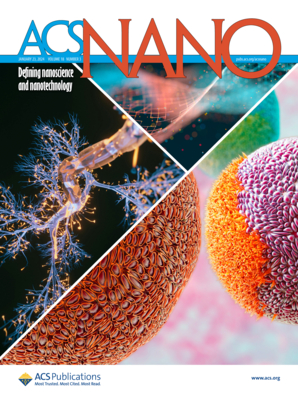用于仿生表皮电极的具有分层封闭结构的超薄自愈合纳米纤维膜
IF 15.8
1区 材料科学
Q1 CHEMISTRY, MULTIDISCIPLINARY
引用次数: 0
摘要
在表皮电极中集成自愈合功能对于提高其可靠性和使用寿命至关重要。自愈合纳米纤维材料重量轻、透气性强,被认为是构建超薄、长效可穿戴表皮电极的理想候选材料。然而,由于纤维之间存在强烈的相互作用,自愈合纳米纤维膜无法稳定存在。因此,自愈合透气纳米纤维表皮电极的开发仍是一大挑战。本文报告了一种结合分子和空间限制的分层限制策略,以克服自愈合纳米纤维之间的超分子氢键,并开发出一种具有神经网状结构的超薄自愈合纳米纤维表皮电极。它可以通过与皮肤或植物的长期保形附着实现电生理信号的实时监测,并且不会对皮肤健康或植物生长产生不良影响。由于表皮电极对使用者和植物几乎没有影响,这为开发生物兼容、自愈、可穿戴的柔性电子器件奠定了基础。本文章由计算机程序翻译,如有差异,请以英文原文为准。

Ultrathin Self-Healing Nanofibrous Membrane with a Hierarchical Confined Structure for Biomimetic Epidermal Electrodes
Integrating self-healing capabilities into epidermal electrodes is crucial to improving their reliability and longevity. Self-healing nanofibrous materials are considered an ideal candidate for constructing ultrathin, long-lasting wearable epidermal electrodes due to their lightweight and high breathability. However, due to the strong interaction between fibers, self-healing nanofiber membranes cannot exist stably. Therefore, the development of self-healing and breathable nanofibrous epidermal electrodes still remains a major challenge. Here, a hierarchical confinement strategy that combines molecular and spatial confinement to overcome supramolecular hydrogen bonding between self-healing nanofibers is reported, and an ultrathin self-healing nanofibrous epidermal electrode with a neural net-like structure is developed. It can achieve real-time monitoring of electrophysiological signals through long-term conformal attachment to skin or plants and has no adverse effects on skin health or plant growth. Given the almost imperceptible nature of epidermal electrodes to users and plants, it lays the foundation for the development of biocompatible, self-healing, wearable, flexible electronics.
求助全文
通过发布文献求助,成功后即可免费获取论文全文。
去求助
来源期刊

ACS Nano
工程技术-材料科学:综合
CiteScore
26.00
自引率
4.10%
发文量
1627
审稿时长
1.7 months
期刊介绍:
ACS Nano, published monthly, serves as an international forum for comprehensive articles on nanoscience and nanotechnology research at the intersections of chemistry, biology, materials science, physics, and engineering. The journal fosters communication among scientists in these communities, facilitating collaboration, new research opportunities, and advancements through discoveries. ACS Nano covers synthesis, assembly, characterization, theory, and simulation of nanostructures, nanobiotechnology, nanofabrication, methods and tools for nanoscience and nanotechnology, and self- and directed-assembly. Alongside original research articles, it offers thorough reviews, perspectives on cutting-edge research, and discussions envisioning the future of nanoscience and nanotechnology.
 求助内容:
求助内容: 应助结果提醒方式:
应助结果提醒方式:


